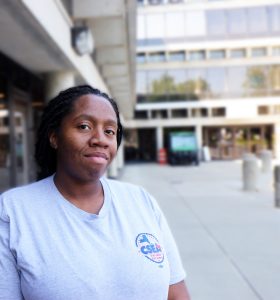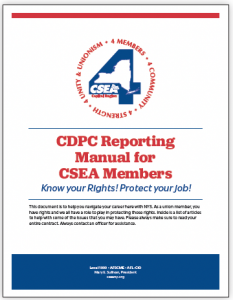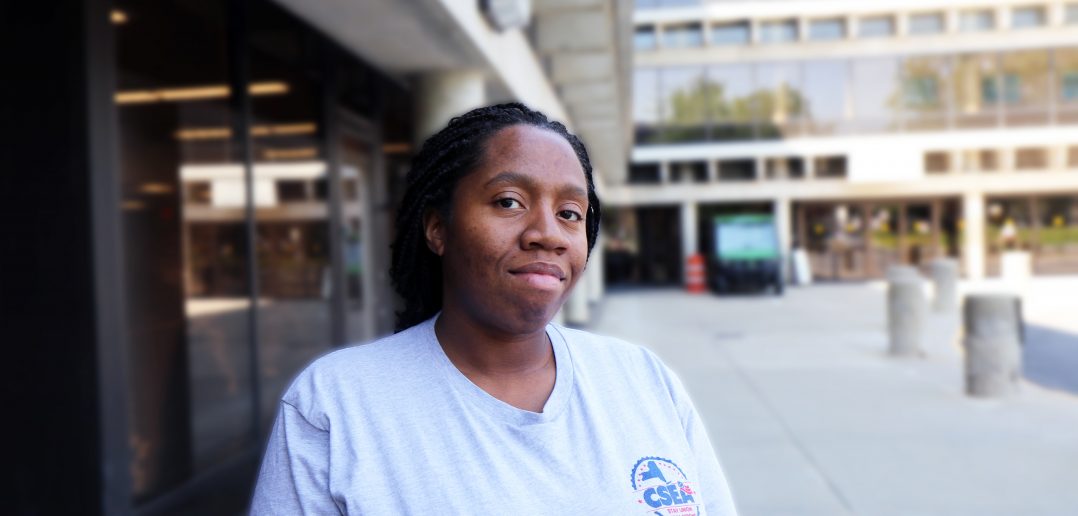
CSEA Capital District Psychiatric Center Local President Zakiya Rhymer, shown here outside her worksite during a break, led efforts to improve safety at the center following an assault on a co-worker.
ALBANY — In the early morning hours of Feb. 16, 2023, before her work shift was due to begin, CSEA Capital District Psychiatric Center (CDPC) Local President Zakiya Rhymer got a devastating call that became a catalyst for change.
Rhymer learned that Ronda Davidson, a secure care treatment aide at CDPC, was assaulted by a patient. Davidson suffered multiple cuts, a broken eye socket and was bleeding profusely from her head and face. She was taken to Albany Medical Center.
Rhymer soon received by text a photo of Davidson’s bloodied and swollen head.
“I just started crying,” said Rhymer. “I don’t know if I was crying from being sad or being angry, but I just sat there and cried.”
Few options for workers
Rhymer warned something like this could happen – again.
One week before Davidson was injured, Rhymer, in a meeting with CDPC management, pressed for stronger safety protocols to avoid another assault like the one on CDPC employee Darryl Best, who was severely injured as a result of an assault by a CDPC patient in February 2022. He suffered a traumatic brain injury and likely won’t be able to return to work.
Direct care workers often have very complicated decisions to make instantaneously during incidents where their safety could be jeopardized. For instance, if a worker defends themselves against an assault by putting a patient in a restraint. If that restraint isn’t performed exactly to agency procedures and policy, members could face discipline. In many cases, those charges do not take into account that the individual being placed in a restraint does not cooperate with that restraint, causing potential policy violations.
If workers leave the side of a patient who requires a Constant Observation (CO) sit to help a co-worker or other patient under attack, they could be found in violation of policy. Because of this, many workers feel powerless to help their co-workers during incidents.
“Three of us were on CO (constant observation) sits,” said Lisa Farrish, a CDPC secure care treatment aide who was nearby when Davidson got assaulted. “I won’t ever forget this incident. I live it every day.”
By the numbers
While CDPC management is fast to act on Justice Center disciplines, properly managing staff and patients and adherence to state reporting and safety regulations had been lackluster.
Previous CSEA officers for years had tried to get traction on issues of severe understaffing, crushing mandates, workplace safety, injuries and health and safety violations.
A 25-page data analysis compiled by CSEA’s OSH Department in February 2020 studied the state Department of Labor’s Work Related Injuries and Illnesses (SH-900) logs from the facility from 2017 through 2019.
The findings show that CSEA bargaining unit members were the most at-risk group of employees in the facility. About a third of recordable incidents were for the CSEA title of Secure Care Treatment Aide and 85% of the causes were identified as patient interaction.
Of the six recordable incidents classified, the largest primary cause was “Struck by an Object” happening in almost 50% of recorded incidents. Employees in these titles are injured at a rate greater than 25% of the statewide average.
One of the key recommendations from the report was to “develop a safety program that promotes employees’ participation at all levels. The systems that work best are one’s free of reprisal for reporting incidents and near misses.”
An updated analysis completed by CSEA’s OSH Department in May 2023 found that of the 282 recordable incidents over the dataset, 233 (82.6%) had their cause identified as patient interaction. 90% of all the cases had patient interaction labeled as their secondary cause.
Union takes action
After learning of the attack on Davidson, Rhymer decided enough was enough and set out to improve the center’s workplace safety standards.
Rhymer, after processing the incident and the actions she wished to pursue, contacted her CSEA Labor Relations Specialist, Alexandra Molina.
Within minutes of learning about the incident, Molina helped Rhymer set our union’s path for change by contacting CSEA Capital Region Director Denise Warren and Capital Region President Ron Briggs.
Shortly after, Briggs led the way in assembling a response team that included CSEA Capital Region and Headquarters staff in the Communications, Occupational Safety and Health, Legislative and Political Action and State Operations departments.
Group members were briefed on the incident, and updated on previous incidents as well as the status of state Public Employee Safety and Health (PESH) Bureau filings. The group identified targeted issues, among them the need for staff to report any workplace incident even if it seemed minor, to ensure that all incidents were accounted.

CDPC Reporting Manual for CSEA members.
Members were informed of workplace safety updates via Action Network emails and robocalls. Rhymer worked with our union’s Communications Department to publish a reporting manual for members to know their contractual rights and urge reporting of all incidents. The manual includes local CSEA officer contact information, contract abstracts and Workplace Violence Incident reporting forms.
Briggs emailed and met in person with state legislators and officials to discuss the assault and fight to improve workplace safety.
Working with our union’s response group, Briggs also sent a letter to CDPC and state Office of Mental Health (OMH) management demanding that the center be evaluated for potential workplace violence hazards as part of the state’s Workplace Violence Prevention law, immediately transfer to another facility the patient who assaulted Davidson as required under NYS CRR Part 57.3(a), immediately form a response team, create an Agency Safety Director and send to our union new hire data to address chronic understaffing.
Also copied on the letter were two state Assemblymembers and two state Senators from the Capital District, some of whom subsequently wrote letters to CDPC management in support of CDPC staff.
Meanwhile, CSEA’s State Operations Department staff worked with Statewide OMH Labor- Management Committee Chair Lovette Mootry and committee members to address the issue with OMH officials, including through numerous meetings and calls that sometimes took place during late-night hours and weekends.
Real results
State OMH officials, including the commissioner, responded quickly and very positively to our union’s letter and to labor-management efforts. OMH management ensured that significant positive changes were made.
The first sign of positive change happened within a few days of the letter being received. The patient who assaulted Davidson was transferred to a downstate facility better equipped to handle the most assaultive patients.
Rhymer was invited to attend, for the first time, a management meeting to help determine the factors that lead to Davidson’s assault and how these factors can be mitigated in the future.
Management also updated Rhymer on new hires and recruitment plans to address staffing shortages. Most staff members have worked mandatory overtime shifts to the point of physical and mental exhaustion.
The facility conducted a safety walk-through. Management also adjusted already-planned renovations to include broader observational areas and less restricted spaces between doors. The concrete pillar that Davidson was knocked into has since been replaced with floor-to-ceiling Plexiglas and more retro-fits are planned.
Briggs praised response team members for their efforts.

Briggs
“This is what unions are about and this is how change happens when we work together,” said Briggs.
In late May, our union saw another victory when the state Office of Mental Health posted a new position, Agency Safety and Health Director, to better coordinate safety efforts throughout the agency.
Farrish said she feels what happened to Davidson was a catalyst for change.
“Things are getting better,” said Farrish. “Kay (Rhymer) is our secret weapon.”
Rhymer credits local officers who kept day-to-day union business moving while she was focusing on making these changes. She also gives credit to our union’s resources that put pressure on management.
“Everything moved so fast,” said Rhymer. “That’s when I realized how many resources CSEA really has. It really just takes one phone call.”
Rhymer noted that our union’s actions have led to real change.
“We are having an impact,” said Rhymer. “Change is noticeable. Staff is reaching out more. It is a changing atmosphere. At the end of the day, we know we work in a dangerous job, but we should all be able to walk out the door at the end of the day the same way we came in.”
— Therese Assalian



